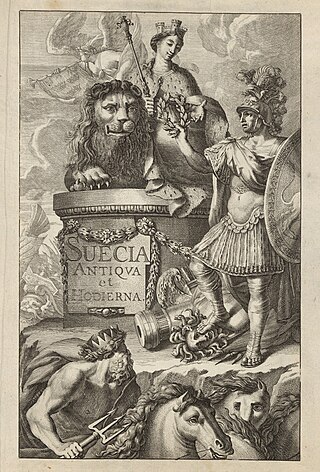| |||||
| Decades: | |||||
|---|---|---|---|---|---|
| See also: | |||||


Events from the year 1701 in Sweden
| |||||
| Decades: | |||||
|---|---|---|---|---|---|
| See also: | |||||


Events from the year 1701 in Sweden

Frederick I was King of Sweden from 1720 until his death, having been prince consort of Sweden from 1718 to 1720, and was also Landgrave of Hesse-Kassel from 1730. He ascended the throne following the death of his brother-in-law absolutist Charles XII in the Great Northern War, and the abdication of his wife, Charles's sister and successor Ulrika Eleonora, after she had to relinquish most powers to the Riksdag of the Estates and thus chose to abdicate. His powerless reign and lack of legitimate heirs of his own saw his family's elimination from the line of succession after the parliamentary government dominated by pro-revanchist Hat Party politicians ventured into a war with Russia, which ended in defeat and the Russian tsarina Elizabeth getting Adolf Frederick of Holstein-Gottorp instated following the death of the king. Whilst being the only Swedish monarch called Frederick, he was Frederick I of Hesse-Kassel and thus Frederick I also of Sweden, though other Swedish monarchs with non-repeating names have not been given numerals.

Charles XII, sometimes Carl XII or Carolus Rex, was King of Sweden from 1697 to 1718. He belonged to the House of Palatinate-Zweibrücken, a branch line of the House of Wittelsbach. Charles was the only surviving son of Charles XI and Ulrika Eleonora the Elder. He assumed power, after a seven-month caretaker government, at the age of fifteen.

The monarchy of Sweden is centred on the monarchical head of state of Sweden, by law a constitutional and hereditary monarchy with a parliamentary system. There have been kings in what now is the Kingdom of Sweden for more than a millennium. Originally an elective monarchy, it became a hereditary monarchy in the 16th century during the reign of Gustav Vasa, though virtually all monarchs before that belonged to a limited and small number of political families which are considered to be the royal dynasties of Sweden.

Hedvig Sophia Augusta of Sweden, Duchess of Holstein-Gottorp, was the eldest child of Charles XI of Sweden and Ulrike Eleonore of Denmark. She was heir presumptive to the Swedish throne from her birth until that of her brother one year later and again from the start of his reign as King of Sweden, in 1697, until her death and the regent of the duchy of Holstein-Gottorp for her minor son from 1702 to 1708. Some sources refer to her as Sofia.

The Swedish invasion of Poland (1701–1706), also known as Charles XII's invasion of Poland or the Polish front of the Great Northern War, was a conflict in eastern Europe overshadowed by the ongoing Great Northern War fought between the Swedish Empire against the Russian Empire, Denmark-Norway, Saxony and the Polish–Lithuanian Commonwealth. The Polish front was a major part of the greater conflict, and it included some decisive battles in favor of the Swedes that contributed to the length of the war.

Events from the year 1839 in Sweden

Events from the year 1766 in Sweden
Events from the year 1763 in Sweden

Events from the year 1735 in Sweden

Events from the year 1717 in Sweden

Events from the year 1708 in Sweden

Events from the year 1731 in Sweden

Events from the year 1716 in Sweden

Events from the year 1713 in Sweden

Events from the year 1709 in Sweden

Events from the year 1704 in Sweden

Events from the year 1700 in Sweden

Events from the year 1644 in Sweden
Events from the year 1664 in Sweden

The Battle of Tryškiai, (Tryszki or Triski), on 4–5/5–6/15–16 December 1701, was a small engagement between the Swedish forces under the command of the Swedish King Charles XII and the Polish–Lithuanian Commonwealth’s forces under the command of the Polish-Lithuanian Field Hetman Grzegorz Antoni Ogiński, in the town of Tryškiai of the Duchy of Samogitia. After the Crossing of the Düna Charles XII went into an alliance with the Sapieha family to gain his support in dethroning Augustus II the Strong from the Polish-Lithuanian throne, in exchange for protection from rival families in Samogitia, such as the Ogiński family. After initial engagements between the Swedish forces and those loyal to Grzegorz, the Swedish King personally takes command of the troops and engages Grzegorz at the town of Tryškiai; after a brief encounter, Grzegorz is forced on the run and, with Charles XII being hot on his heels, eventually retreats out of Samogitia altogether. A Swedish detachment is established at Kaunas in the Grand Duchy of Lithuania, as a sort of forward operating base before the inevitable Swedish invasion of Poland (1701–1706); further engagements, foremost the Battle of Darsūniškis, confirms the Swedish invasion. Although only a small action in a major war, the battle quickly sparked false rumours to be spread around Europe; one spoke of Charles XII’s death somewhere in Lithuania, while the other mentioned a major defeat for Grzegorz, involving many thousands of participants.
![]() Media related to 1701 in Sweden at Wikimedia Commons
Media related to 1701 in Sweden at Wikimedia Commons